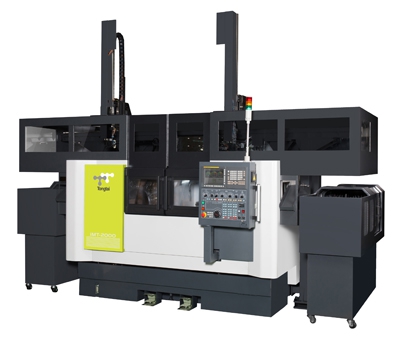
Tongtai's newest MT series lathes were developed for improving cycle times and turning processes for the automotive industry where small parts are typically made within 60 seconds. After many years of working together on customizing machines and turnkey projects with automotive customers worldwide, Tongtai developed the MT series for precision turning, high production volume, automatic production, and insertion into mass-production lines. Tongtai machines are available from Absolute Machine Tools Inc.
The MT series has twin spindles and two individual machining areas. The turrets and spindles are designed parallel to each other. This design makes parts that usually need two processes to be finished on one machine. The addition of a gantry-type robot saves floor space and improves labor flexibility. Depending on cycle time, a single robot arm/single stocker or twin robot arms/twin stockers for high production chucking work are both available on these lathes. The Tongtai MT lathes come equipped with either 6" or 8" chucks on spindles that rotate at 6,000 or 4,500 RPMs respectively. The control system offers a robot teaching function so that the operator can adjust positioning. The function coordinates the robot arm, on-screen positioning diagram, input coordinates, number and names of positions, three axes settings and single axis settings.
The work area on the main foundation of the lathes has two individual working areas with separate bed structures. This design decreases the transferring of harmonic vibration, contributing to excellent machining accuracy and high quality surface finishes. The compact design allows for a short cutting flow from start to finish, which enhances machining rigidity and heavy cutting ability. Maximum swing diameter is 210mm with a machining diameter of 210mm or 120mm (with robotic arm), and machining length of 145mm or 100mm (with robotic arm).
The MT series lathes are equipped with workpiece positioning protection to ensure sealing between the workpiece surface and chuck. Pneumatic pressure leaks can be detected, and if this occurs, the robot arm will reload the workpiece. The gantry type robotic arm is able to process three axes of movement and is driven by a servomotor. The programmable arm allows the operator to adjust positioning points and moving routes. Rapid traverse for the robotic arm are 160m/minute in X, 120m/minute in Y, and 35m/minute in Z. The rotary axis moves at 180° in one second.
The pallet stocker comes in three types: three poles and a center, three poles, and a central pole type. The number of pallets ranges from 10, 14, and 16 with allowable part diameters all at 30mm through 150mm.
The MT series comes standard with coolant through the spindle, A2-5 or A2-6 spindle nose, 0.001" indexing increments, 4,500 RPMs or 6,000 RPMs optional. With cutting feed rates of 0.001-5,000mm/minute this horizontal turning center is perfect for high production fast-paced manufacturing environments.
Contact Details
Related Glossary Terms
- chuck
chuck
Workholding device that affixes to a mill, lathe or drill-press spindle. It holds a tool or workpiece by one end, allowing it to be rotated. May also be fitted to the machine table to hold a workpiece. Two or more adjustable jaws actually hold the tool or part. May be actuated manually, pneumatically, hydraulically or electrically. See collet.
- coolant
coolant
Fluid that reduces temperature buildup at the tool/workpiece interface during machining. Normally takes the form of a liquid such as soluble or chemical mixtures (semisynthetic, synthetic) but can be pressurized air or other gas. Because of water’s ability to absorb great quantities of heat, it is widely used as a coolant and vehicle for various cutting compounds, with the water-to-compound ratio varying with the machining task. See cutting fluid; semisynthetic cutting fluid; soluble-oil cutting fluid; synthetic cutting fluid.
- feed
feed
Rate of change of position of the tool as a whole, relative to the workpiece while cutting.
- parallel
parallel
Strip or block of precision-ground stock used to elevate a workpiece, while keeping it parallel to the worktable, to prevent cutter/table contact.
- rapid traverse
rapid traverse
Movement on a CNC mill or lathe that is from point to point at full speed but, usually, without linear interpolation.
- turning
turning
Workpiece is held in a chuck, mounted on a face plate or secured between centers and rotated while a cutting tool, normally a single-point tool, is fed into it along its periphery or across its end or face. Takes the form of straight turning (cutting along the periphery of the workpiece); taper turning (creating a taper); step turning (turning different-size diameters on the same work); chamfering (beveling an edge or shoulder); facing (cutting on an end); turning threads (usually external but can be internal); roughing (high-volume metal removal); and finishing (final light cuts). Performed on lathes, turning centers, chucking machines, automatic screw machines and similar machines.








